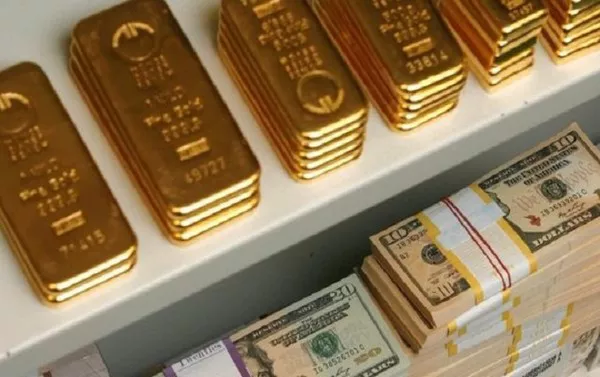Silver certificates stand as an enduring symbol of America’s monetary evolution. Originating in the late 19th century, they were a tangible representation of the country’s transition from a bimetallic to a monometallic standard. The Coinage Act of 1873 demonetized silver as a basis for currency, leaving the gold standard as the sole monetary system. This move caused uproar among silver advocates, leading to the passage of the Bland-Allison Act in 1878, which mandated the purchase of silver bullion to be minted into coins.
However, with vast quantities of silver stockpiled in government vaults, the need for a more efficient means of utilizing this resource became apparent. Hence, the birth of the silver certificate. Authorized by the Sherman Silver Purchase Act of 1890, these certificates were backed by and redeemable for silver dollars. They offered a convenient alternative to carrying heavy silver coins and provided a flexible currency system that could expand or contract with the nation’s economic needs.
Redemption Value
Although silver certificates were once redeemable for silver on demand, this practice ceased in the mid-20th century. The Silver Purchase Act of 1963 effectively ended the redemption of silver certificates for silver bullion, making them obsolete in terms of their original purpose. However, they retained their status as legal tender, meaning they can still be used for transactions at their face value. This face value typically corresponds to the denomination printed on the bill, such as $1, $5, or $10.
Collectible Value
The allure of silver certificates extends beyond their face value, with many collectors drawn to their historical significance and aesthetic appeal. Several factors contribute to the collectible value of these certificates:
Rarity: Some series or denominations of silver certificates are rarer than others due to limited production or circulation. For example, certain series issued in smaller quantities or during specific periods of history may command higher prices among collectors.
Condition: As with any collectible item, the condition of a silver certificate significantly influences its value. Certificates that are well-preserved, free from damage, and retain their original crispness are generally more desirable to collectors.
Series: Silver certificates were issued in various series over the years, each bearing unique designs and features. Certain series may be more sought after by collectors due to their historical significance or aesthetic appeal.
Unique Features: Some silver certificates possess distinctive characteristics that make them particularly valuable. This could include printing errors, misalignments, or rare serial number patterns that add to their collectibility.
Market Value
Determining the market value of silver certificates involves assessing various factors, including condition, rarity, and demand among collectors. Current market values for common silver certificates can vary widely depending on these factors. As of [current date], here are approximate market values for common silver certificates in different conditions and series:
- 1935 $1 Silver Certificate, Average Circulated Condition: $1.25 – $3.00
- 1899 $1 Silver Certificate, Fine Condition: $50 – $100
- 1928 $5 Silver Certificate, Gem Uncirculated Condition: $200 – $500
These values are based on recent auction sales, collector demand, and the overall condition of the certificates. It’s essential to research specific certificates and consult with reputable numismatic experts to obtain accurate market values.
Buying and Selling Tips
For those interested in buying or selling silver certificates, consider the following tips:
Research: Familiarize yourself with different series, denominations, and condition grades of silver certificates to make informed purchasing or selling decisions.
Authentication: When purchasing silver certificates, ensure their authenticity by buying from reputable dealers or obtaining certification from professional grading services.
Condition Assessment: Carefully evaluate the condition of silver certificates before making a purchase or sale. Minor differences in condition can have a significant impact on their market value.
Market Trends: Stay informed about current market trends and collector preferences to identify buying and selling opportunities.
Fair Pricing: When selling silver certificates, aim for fair and transparent pricing based on their condition, rarity, and market demand. Likewise, be cautious when purchasing certificates at prices significantly above or below their market value.
Networking: Build relationships with other collectors, dealers, and numismatic experts to exchange knowledge, tips, and insights about silver certificates.
Preservation
Proper storage and preservation are crucial for maintaining the condition and value of silver certificates. Here are some tips to help preserve these collectible items:
Handle with Care: Avoid excessive handling of silver certificates, as this can lead to creases, tears, or smudges.
Storage: Store silver certificates in archival-quality holders, sleeves, or albums designed specifically for currency collection. These materials help protect certificates from environmental damage, such as moisture, light, and dust.
Temperature and Humidity Control: Maintain stable temperature and humidity levels in storage areas to prevent deterioration of paper and ink.
Avoid Display in Direct Sunlight: Exposure to direct sunlight can cause fading and discoloration of silver certificates over time. Display them in areas away from windows or direct sunlight.
Avoid Laminating or Adhesives: Refrain from laminating or using adhesive materials on silver certificates, as this can damage the paper and decrease their value.
Legal Aspects
Collecting and trading silver certificates generally involve no legal restrictions, as they are considered historical artifacts and legal tender. However, it’s essential to be aware of any regulations regarding the sale or purchase of collectible currency in your jurisdiction. Additionally, ensure compliance with tax laws regarding the reporting of income from the sale of collectible items.
Conclusion
In conclusion, while silver certificates may no longer serve their original purpose as redeemable notes for silver, they continue to hold value as historical artifacts and collectible items. Understanding their historical context, redemption value, collectible value, market dynamics, and proper preservation techniques is essential for collectors and enthusiasts alike. With careful research, attention to detail, and a passion for numismatics, exploring the world of silver certificates can be both rewarding and enlightening.

